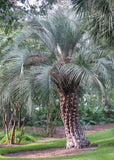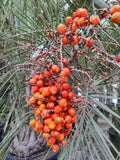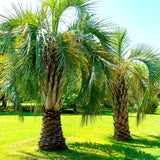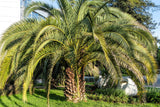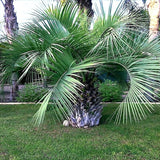“Amber Kiss” Butia capitata Seed Collection — The Sweet-Fruit Palm of Sun & Sky
Awaken dreams of subtropical skies and mango-kissed breezes in your garden with this enchanting packet of Butia capitata seeds — the jelly palm whose coral-orange fruits and graceful arching fronds carry stories from Brazil’s cerrado into your landscape.
🌴 Botanical Legend & Cultural Roots
In its native Brazil, Butia capitata is known as “butiá” or “coquinho-azedo,” names whispered among rural communities as they harvest its fruit to fashion jellies, liqueurs, preserves, and ice creams. Its pulp is bright orange, richly aromatic and prized locally as a vitamin A–rich delicacy.
Long before modern cultivation, groves of Butia palms dotted the savanna habitats and sandy grasslands, forming cultural and ecological backbones in traditional landscapes.
Because of taxonomic confusion, many “jelly palms” in cultivation have been reclassified (notably Butia odorata), but B. capitata in its strict sense remains a storied and rarer treasure in tropical palm circles.
The genus name Butia arises from local vernacular in Brazil; capitata (meaning “headed” or “crowned”) may refer to the dense crown of arching fronds or to vernacular references to “cabeçudo” (big-headed) palms.
✿ Blooms, Fragrance & Wildlife
When mature, each palm sends forth interfoliar inflorescences hidden among the fronds. The long flowering stalk (sometimes over a meter) reveals clusters of tiny pale yellow to cream blossoms, each bearing sweet floral scent that entices pollinators.
The pollination biology of Butia capitata is richly diverse — in cultivated settings, scientists have documented more than 30 species of insect visitors, including beetles, flies, bees, and other floral foragers.
Recent studies reaffirm that Butia palms are valued sources of pollen and nectar for bees and pollinating insects, especially in ecosystems where floral resources are otherwise scarce.
While I found no specific records confirming B. capitata as a larval host for butterflies or moths, its blossoms provide sustenance to a host of pollinators. Bees especially are drawn to the sweet nectar and pollen.
Once flowering gives way to fruit, the ovoid orange drupes (often ~1 inch in diameter) ripen between late winter and spring in warm regions; the richly flavored pulp is a delight to birds, small mammals and humans alike.
❄ Hardiness, Growth & Conditions
-
USDA Hardiness Zones: Generally Zone 9 to 11 (some sources suggest B. capitata might survive marginally in zone 8b in sheltered sites)
-
Mature palms typically reach 20 to 35 ft tall with a modest trunk diameter (0.5–1.5 ft), and a crown spanning 10–15 ft.
-
Leaves are pinnate and arch gracefully, often in a bluish-green or gray-green hue.
-
Light: thrives in full sun to part shade — full sun encourages fruit production.
-
Soil: prefers moist, well-draining, fertile soils; does not tolerate prolonged waterlogging.
-
Drought tolerance improves with age, thanks to deeper roots on established plants.
-
Cold: mature individuals can survive brief dips toward ~15–20 °F in ideal conditions, but frost or extended cold is dangerous especially for younger plants.
🌱 Why Grow These Seeds?
-
Exotic utility & aesthetics — You’re growing not just a palm, but a living factory of palm jellies, juices, and tropical architecture.
-
Pollinator magnet — Insects and bees will frequent your palm’s scented flowers, enhancing biodiversity in your garden.
-
Cultural heritage — Cultivating B. capitata is a gesture toward the palm-grove landscapes of Brazil, where palm culture, fruit harvests, and ecological communities intertwine.
-
Slow-reveal drama — From seed to trunk and fruit, the journey is gradual but rewarding: each stage holds a spark of tropical transformation.
-
Conservation & rarity — Because of taxonomic revisions and misidentifications, genuine Butia capitata in cultivation is rarer than you think — your seedlings could help preserve genetic lines.
Sow these seeds and nurture the memory of sunlit Brazilian fields in your own soil. Imagine one day gazing upon a noble jelly palm, its fragrant blossoms humming with pollinators, its golden fruit swaying in warm breezes — a living emblem of tropical heritage and garden wonder.






